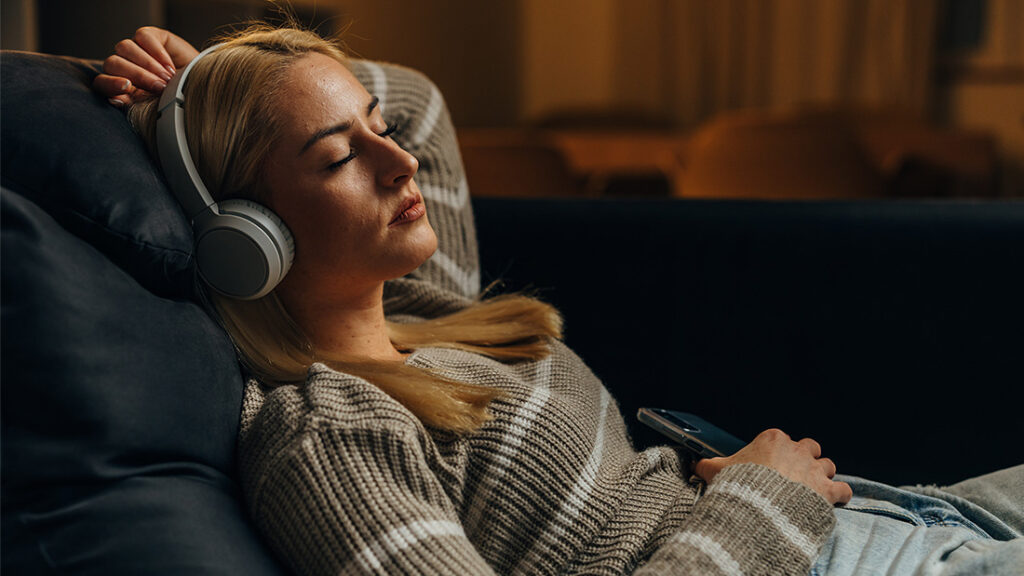
Long Story Short
- Nearly 24 percent of people fall asleep to sounds like music or a podcast, making it a more common technique than reading a book, using a phone, or counting sheep to get to sleep.
- The best sounds for sleep vary depending on personal preferences, but options like colored noise, soothing music, guided meditations, ASMR, and nature sounds can all help you relax and fall asleep more easily.
- White noise, the most popular type of colored noise according to a Sleepopolis survey, has been found to improve sleep for those who live in noisy environments.
- Studies show that listening to calming music before bedtime can be beneficial for individuals struggling with insomnia.
The gentle patter of rain on your window, the soft hum of a fan, or gentle classical music — if these sounds help you drift off, you’re not imagining it. Scientists have researched how different sounds can promote sleep, and there’s definitely merit to this sleep strategy. (1) Though you might think noise can only disrupt sleep, some sounds can actually be helpful come bedtime. Below, we dig into why some sounds work for sleep and the best sleep sounds out there.
Note: The content on Sleepopolis is meant to be informative in nature, but it shouldn’t be taken as medical advice, and it shouldn’t take the place of medical advice and supervision from a trained professional. If you feel you may be suffering from any sleep disorder or medical condition, please see your healthcare provider immediately.
Why Use Sounds to Help You Sleep?
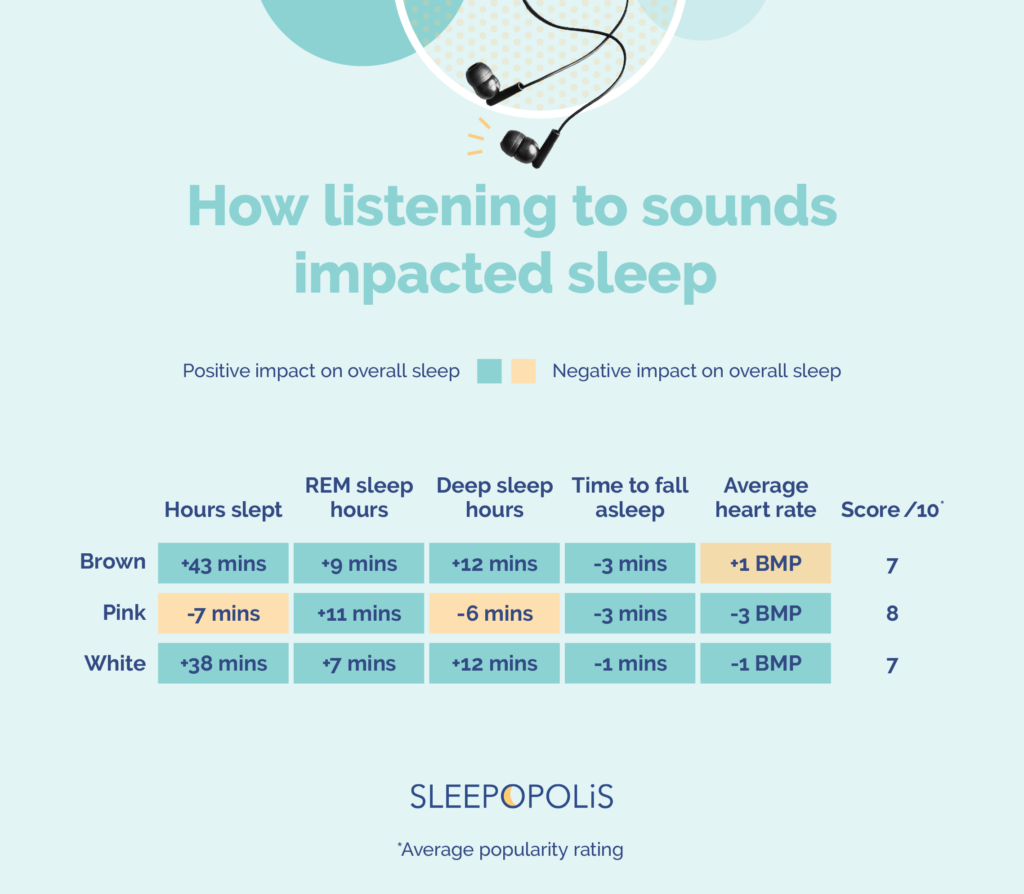
If you’ve ever been woken up by a sudden noise — maybe a passing siren or the neighbor’s dog barking — you know how hard it can be to settle back into sleep. Luckily, there’s a way to use sound to create a buffer against these unwanted disturbances.
Here’s how it works: Sleep is made up of a series of stages, including light sleep, deep sleep, and rapid eye movement (REM) sleep. (2) Loud noises can disrupt your sleep cycle by triggering the production of cortisol, a stress hormone that keeps you alert. (3) As a result, we might find ourselves tossing and turning, struggling to catch those precious hours of sleep.
“As you enter deep and dream sleep, your brain works to filter out those louder noises, like those from outside your street as the local bar closes down or ongoing traffic that passes by your home,” licensed psychotherapist Noah Kass tells Sleepopolis. The filtering process allows your brain and body to focus on recovery and repair so you can be at your best for the next day, he explains. (4)
So, how does using sound help with sleep? Continuous sounds, like white noise (which we’ll get into later), can create a backdrop that helps drown out those random noises that might wake you up, Scott Peterson, SVP of Product Management at Yogasleep, tells Sleepopolis. (5)
Even while we sleep, our hearing stays alert and may react to sounds it senses as important, and the louder the noise, the more likely it is to wake us. (6) By creating a consistent backdrop, continuous background noise (like colored noise or music) can make it harder to hear that sleep-disturbing street traffic or midnight garbage truck. (5)
Still, it’s important to note that everybody is going to feel differently about using sounds for sleep: one person might need total silence, and another might find some steady, quiet white noise lulls them right to sleep. Try experimenting with the different sounds to find which — if any! — are right for you.
The Best Sleep Sounds
Science has some interesting findings when it comes to sleep sounds. Some studies show that certain types of sounds may help reduce how long it takes to fall asleep and reduce sleep disruption. (5) (7) But others show mixed results or no proof that sound helps with sleep. (6) (8) At this point, more research is needed to fully understand how different sounds affect our sleep quality.
Still, many people fall asleep to sounds like music or podcasts, making it more popular than reading or counting sheep. (9) To see what works for people, we conducted a small Sounds of Sleep experiment, testing out how different sounds affect sleep quality through sleep trackers and analyzing trends from TikTok and Reddit. Let’s look at the most common sleep sound options:
Colored Noise
If the idea of colors having sounds seems strange, let’s bring you up to speed. Sound travels in waves, creating vibrations that we hear as different frequencies. (10) Just as light has different colors based on wavelengths, noise can also be grouped by its patterns and frequencies, which scientists label with colors. (11)
A noise’s “color” is a way to describe what frequencies (high or low sounds) are in it and how strong they are. The term “white noise” came first, named because it contains an even mix of all frequencies, just like white light contains all colors. (11) Then, other sound patterns were named after colors based on how their frequency mixes match different colors of light. (11)
Different types of colored noises can help you sleep better in their own ways. White noise, for example, tends to be a little high-pitched and intense — like the sound of a vacuum cleaner, hairdryer, or air conditioning unit — and is great for hiding sudden sounds in noisy places. (12) Pink noise has deeper, softer, lower sound waves and might help your brain relax and get ready for sleep. (6) Brown noise is deeper, with more rumbling bass than white or pink noise. It’s comparable to heavy rainfall or a strong showerhead and can be especially calming for people who find white noise too sharp or high-pitched. (12) Green noise, which sounds like the gentle flow of a forest stream, has quickly become TikTok’s latest favorite sleep sound.
There are quite a few small-scale studies backing up the results of our own Sounds of Sleep experiment. One small study found that white noise helped improve sleep for people who had difficulty sleeping when their environment was noisy. (5) Another found that intensive care unit (ICU) patients who used a white noise app slept significantly better over three days compared to those who didn’t. (13)
But not everyone finds the sound of white noise relaxing, and there is some research that finds continuous noise may be disruptive to sleep. (6) On top of that, some argue that having continuous noise in your bedroom environment could prevent you from hearing important sounds like alarms or a crying baby. (6)
The Most Popular Colored Noises
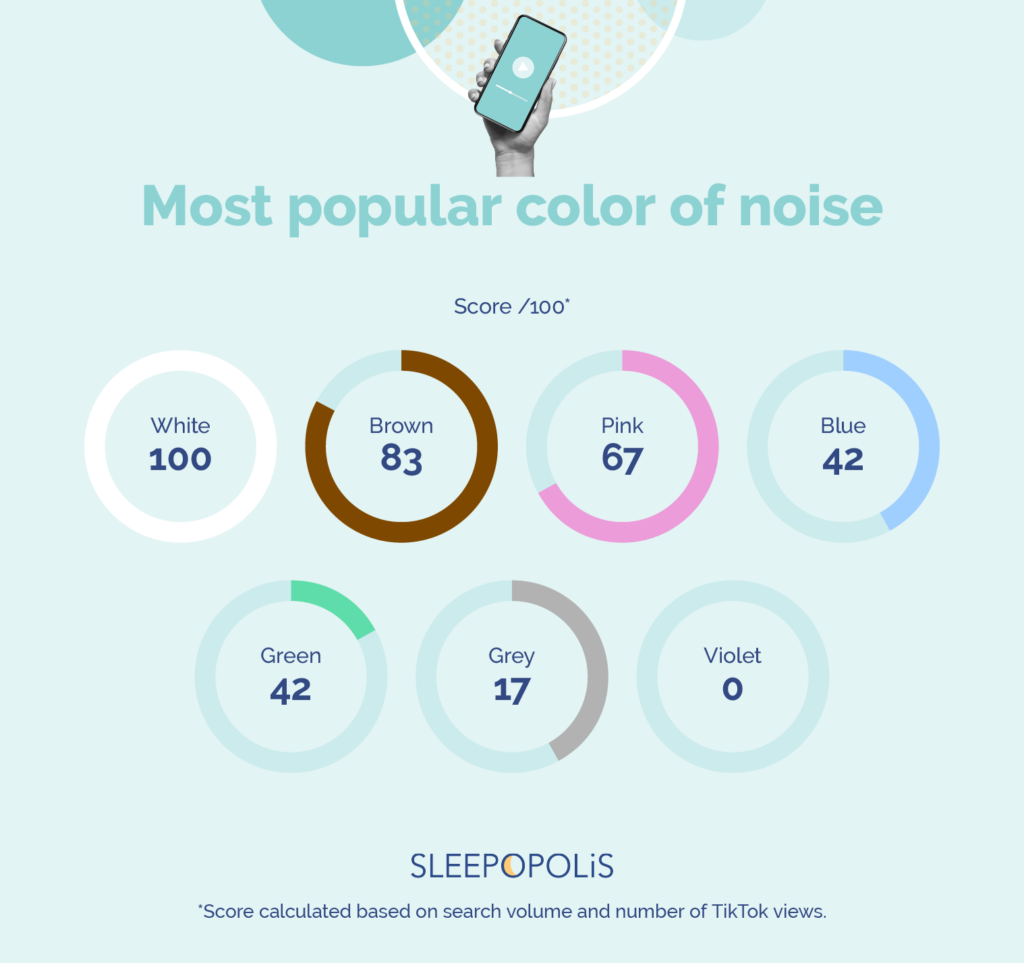
While you’re likely familiar with white noise — the steady, static-like sound that helps block out ambient noise for better sleep — there are lesser-known colored noises that may also make for more restful sleep, and they run the gamut, from pink to green to gray. Here’s how these colored noises ranked in popularity, with results based on search volume and number of TikTok views:
- White: 100 percent
- Brown: 83 percent
- Pink: 67 percent
- Blue: 42 percent
- Green: 42 percent
- Gray: 17 percent
- Violet: 0 percent
Our sleep experiment echoed these findings. Overall, white noise proved to have a positive impact on sleep across all metrics, including total hours slept, time spent in REM and deep sleep, and the time it took to fall asleep. However, brown and pink noise stood out in their own ways:
- Brown noise increased total sleep time by 43 minutes.
- Pink and brown noises had the biggest impact on the time it took participants to fall asleep.
- Pink noise reduced participants’ heart rates by an average of 3 beats per minute compared to sleeping without sound.
- According to our participants, the most popular sound was pink noise, with an average score of 8 out of 10.
ASMR
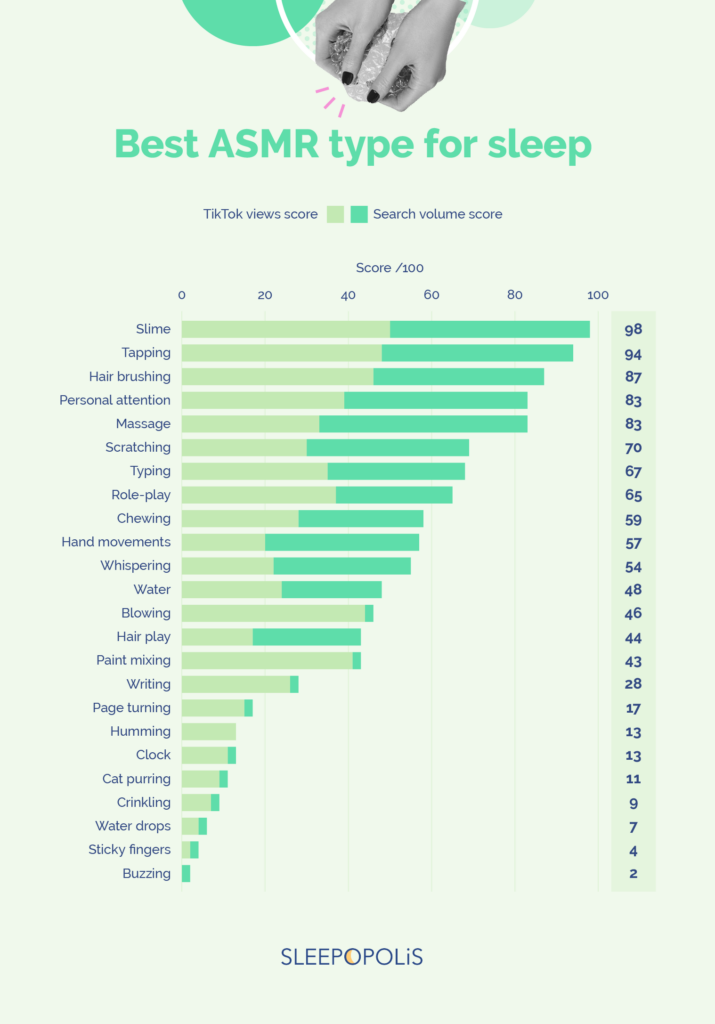
You’re likely familiar with ASMR, or autonomous sensory meridian response, even if you don’t recognize the name. It’s that cozy, tingling feeling some people get when they hear certain gentle sounds — think soft whispering or light tapping, Peterson says. (14) This tingling can begin at the top of your head and travel down your body.
“Watching ASMR videos can decrease your heart rate and improve your overall mood,” says Kass. (15) When you experience ASMR, it’s activating the comfort center of your brain, and even just listening to these soothing sounds, without the visuals, can help your brain shift into a more relaxed state, he adds. (16)
While some people enjoy ASMR for stress relief, it can also play a role in promoting sleep. “Sleep is a vulnerable time, so we fall asleep most easily when we are not feeling stressed or threatened,” Craig Richard, PhD, founder of ASMR University, tells Sleepopolis. He explains that ASMR sounds often naturally make listeners “feel safe, less stressed, and therefore sleepy.” Richard says the feelings triggered by ASMR are likely related to an increased release of oxytocin, which is stimulated by positive personal attention and creates a sense of comfort and relaxation.
In addition to oxytocin, when people experience ASMR, their brains release chemicals like dopamine and endorphins, which may help explain why ASMR can make people feel good, relaxed, and sleepy. (16) However, while ASMR has its benefits, it won’t be everyone’s cup of tea, just like white noise or music for sleep.
You’ll find countless ASMR triggers in real life, online videos, podcasts, and even television shows, including:
- Gentle whispering, considered one of the most common ASMR triggers
- Scratching, blowing, or tapping sounds
- Repetitive sounds, like page turning or writing
- Crinkling of paper or plastic
- Water drops
- Bob Ross’ “The Joy of Painting”
Music
Just as music can fuel your workout or help you beat that afternoon slump, it can also work in reverse. Listening to certain tunes in addition to practicing healthy sleep habits can help quiet your mind and ease you into sleep. (17) Our brain responds differently to music depending on its tempo and style, and certain types of music can be particularly effective for sleep. (18)
Similar to colored noise, soothing music can slow down your heart rate, lower your blood pressure, and help calm your nervous system. (12) It can create a sense of safety and calm that prepares your brain for sleep. (18) And if you find yourself struggling with insomnia, give music a try. A review of studies shows that adding some calming tunes to bedtime routines can help people with insomnia get better sleep. (19)
So, what should you queue up for bedtime? You don’t have to listen to Pachelbel’s Canon in D Major, though you could if it helps. Instead, choose music you find relaxing. (12) “Instrumental or jazz music that isn’t too upbeat or intense, without vocals, can help the body and brain relax. Classical music, especially with piano, has been shown to lower blood pressure,” Kass notes. (12)
Meditations
If counting sheep isn’t helping, how about counting breaths instead and adding in meditation-friendly noises like the relaxing sound of singing bowls and soft chimes? (20) Meditation and meditative music are quickly gaining traction as sleep aids, and it’s no wonder. Research shows that exercise and regular meditation practice can improve your sleep quality, even if you don’t typically have sleep problems. (21)
Meditation works by helping quiet that mental chatter that often keeps us awake at night. It can also improve sleep by lowering stress. (22) People who practice mindfulness meditation may not only sleep better but may also handle sleep-related daytime fatigue better. (21) The benefits aren’t just short-term either — meditation can lead to better sleep quality that lasts for weeks after completing a meditation program. (23)
Nature Sounds
The soft rustling of leaves, birds chirping, or ocean waves rolling onto the beach: these soothing sounds can all have a calming effect. Research shows that nature sounds can help us relax both mentally and physically, especially after a busy day. (24)
“Nature sounds are also great for sleep, likely because they focus attention outward rather than on our own internal anxiety and obsessive thoughts,” Kass explains.
Some helpful nature sounds include: (24) (25)
- Birdsongs
- Ocean waves
- Flowing streams or waterfalls
- Forest sounds
Sleep Stories
Bedtime stories aren’t just for kids anymore. Though research on sleep stories for adults is limited, many people find them helpful for drifting off to sleep. Enjoying a good short story at bedtime can help people feel positive emotions, which can help young and older adults fall asleep faster and stay asleep longer. (26)
Unlike regular audiobooks that keep you hanging on every word, sleep stories are meant to be calming and gentle. They work by encouraging your brain to shut down for sleep instead of running through your work presentation or that awkward conversation from earlier.
Binaural Beats
If you’ve explored sleep sounds, you might have come across binaural beats. They occur when two different tones are played at the same time in each ear through headphones. (27) When your brain processes these tones, it creates a new frequency that can help promote relaxation. (27)
For some people, this unique audio experience can be a helpful sleep aid. (27) According to Peterson, these specially designed sound frequencies might help create the kind of relaxation that leads to better sleep. While everyone responds differently to binaural beats, they offer another interesting option in your sleep-sound toolbox.
Theta Waves
Your brain produces different types of waves throughout the day and night, each associated with a unique mental state. Beta waves occur when you’re alert and focused, alpha waves when you’re relaxed but awake, and theta waves when you’re in that dreamy, meditative state just before sleep. (28)
Theta waves are low-frequency waves that appear when we’re deeply relaxed, meditating, or being creative, Kass explains. These waves can also show up when you’re in those early stages of sleep, like that pleasant, floaty feeling when you’re just starting to drift off. (28)
Research suggests that listening to sounds designed to promote theta waves can help people with insomnia by changing their brain wave patterns, making it easier to transition into sleep. (29) “Certain devices using electronic pulses, light, and sound help people get into the theta state more easily. Binaural beats can also assist us in entering the theta state. The sounds of nature and the sounds of very calming music, without words, help us enter the theta state,” Kass says.
Lullabies
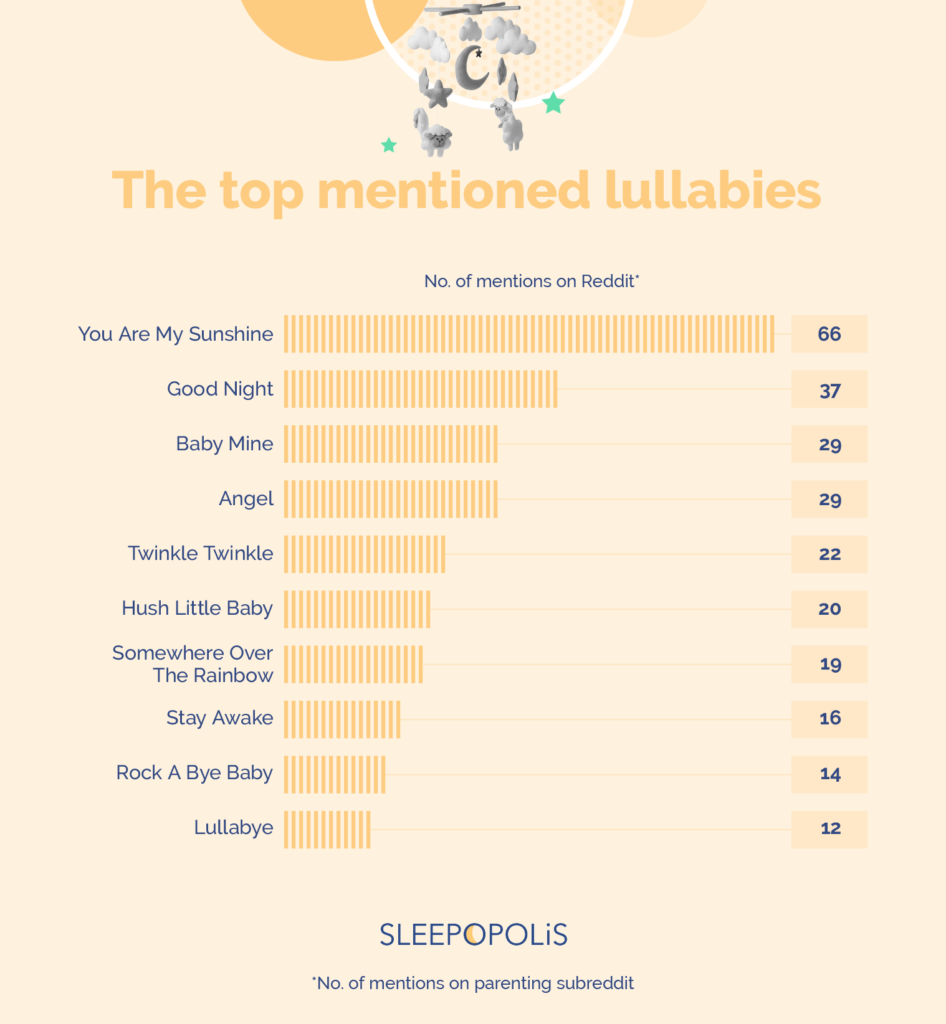
Though research is limited on the actual benefits of playing lullabies for sleep, our experiment dove into popular lullabies as well. Here’s what parents sometimes play for their little ones, based on mentions on Reddit:
- You Are My Sunshine
- Good Night
- Baby Mine
- Angel
- Twinkle Twinkle
- Hush Little Baby
We put together a Spotify playlist of the top lullabies for sleep.
How to Choose the Best Sounds for Your Sleep Needs
Finding the best sounds for your sleep needs depends on your preference. What helps one person drift off might keep another person wide awake. Peterson tells Sleepopolis that while choosing the right sounds is important, good sleep actually starts long before you enter the bedroom. It’s influenced by your daily habits, including exercise, diet, and making time to unwind.
Here are some things to consider when choosing your perfect sleep sound:
- Your noise sensitivity level: If you’re a light sleeper, you might prefer softer, consistent sounds like pink noise rather than sounds that change volume or intensity.
- Your environment: Living on a busy street? Look for sounds that can mask traffic noise, like steady white noise or rainfall.
- Your personal preferences: Choose sounds you naturally find relaxing (if ocean waves remind you of stressful vacations, they probably won’t help you sleep!)
While using sounds for sleep can be helpful, it’s important to keep the volume in check. Experts warn that exposure to sounds at or above 85 decibels can damage your hearing over time. (30) For example, normal conversation is around 60-70 decibels, while music through headphones at maximum volume can blast up to 110 decibels. (30) The louder the sound, the quicker noise-induced hearing loss (NIHL) can occur. So, always keep the volume at a safe level.
FAQs
What color noise is best for sleep?
The best color noise for sleep varies from person to person because it’s about what helps you drift off most easily. Some people love white noise’s steady hum, but others find pink or brown noise more relaxing. What matters most is choosing a sound that masks any disturbing noises and helps you feel relaxed.
Should you listen to music to help you sleep?
Music can be helpful for sleep. (12) Still, not everyone responds to music the same way. If you find music more distracting than relaxing, try other, steadier sleep sounds instead, like white noise or brown noise.
Why do I need noise to sleep?
Many people find consistent background noise helpful for sleep because it can drown out disturbances from noisy environments that might wake them up, like car doors slamming or loud neighbors.
The Last Word From Sleepopolis
At Sleepopolis, we’re passionate about helping you get your best sleep. That’s why we dove deep into the science, consulted with sleep experts, and conducted our own experiments to help you make informed decisions about sleep sounds. In addition to masking background noise, sleep sounds can also soothe a busy mind. And with options like colored noise, nature sounds, ASMR, and music, the world of sleep sounds offers something for everyone.
Sources
Long Story Short Stats
- Bjorvatn B, Waage S, Saxvig IW. Do people use methods or tricks to fall asleep? A comparison between people with and without chronic insomnia. J Sleep Res. 2023;32(2):e13763. doi:10.1111/jsr.13763
- Yoon H, Baek HJ. External auditory stimulation as a non-pharmacological sleep aid. Sensors (Basel). 2022;22(3):1264. doi:10.3390/s22031264
Ebben, M. R., Yan, P., & Krieger, A. C. (2021). The effects of white noise on sleep and duration in individuals living in a high noise environment in New York City. Sleep Medicine, 83, 256–259. https://doi.org/10.1016/j.sleep.2021.03.031 - Feng F, Zhang Y, Hou J, et al. Can music improve sleep quality in adults with primary insomnia? A systematic review and network meta-analysis. Int J Nurs Stud. 2018;77:189-196. doi:10.1016/j.ijnurstu.2017.10.011
Other Sources
- Yoon H, Baek HJ. External auditory stimulation as a non-pharmacological sleep aid. Sensors (Basel). 2022;22(3):1264. doi:10.3390/s22031264
- Brain Basics: Understanding Sleep. National Institute of Neurological Disorders and Stroke. Accessed November 4, 2024. https://www.ninds.nih.gov/health-information/public-education/brain-basics/brain-basics-understanding-sleep
- Liu J, Ghastine L, Um P, Rovit E, Wu T. Environmental exposures and sleep outcomes: A review of evidence, potential mechanisms, and implications. Environ Res. 2021;196:110406. doi:10.1016/j.envres.2020.110406
- Brinkman JE, Reddy V, Sharma S. Physiology of Sleep. In: StatPearls [Internet]. StatPearls Publishing; 2024 Jan. https://www.ncbi.nlm.nih.gov/books/NBK482512/
- Ebben, M. R., Yan, P., & Krieger, A. C. (2021). The effects of white noise on sleep and duration in individuals living in a high noise environment in New York City. Sleep Medicine, 83, 256–259. https://doi.org/10.1016/j.sleep.2021.03.031
- Riedy SM, Smith MG, Rocha S, Basner M. Noise as a sleep aid: A systematic review. Sleep Med Rev. 2021;55:101385. doi:10.1016/j.smrv.2020.101385
- Hu SP, Yang YM, Chen WH, et al. Effect of sleep ambient music on sleep quality and mental health in college students: A self-controlled study. Front Psychol. 2023;14:1171939. doi:10.3389/fpsyg.2023.1171939
- Capezuti E, Pain K, Alamag E, Chen X, Philibert V, Krieger AC. Systematic review: Auditory stimulation and sleep. J Clin Sleep Med. 2022;18(6):1697-1709. doi:10.5664/jcsm.9860
- Bjorvatn B, Waage S, Saxvig IW. Do people use methods or tricks to fall asleep? A comparison between people with and without chronic insomnia. J Sleep Res. 2023;32(2):e13763. doi:10.1111/jsr.13763
- What is the science of sound? National Aeronautics and Space Administration. Accessed November 4, 2024. https://www3.nasa.gov/specials/Quesst/science-of-sound.html#
- Lu SY, Huang YH, Lin KY. Spectral content (colour) of noise exposure affects work efficiency. Noise Health. 2020;22(104):19-27. doi:10.4103/nah.NAH_61_18
- Yoon H, Baek HJ. External auditory stimulation as a non-pharmacological sleep aid. Sensors (Basel). 2022;22(3):1264. doi:10.3390/s22031264
- Warjri E, Dsilva F, Sanal TS, Kumar A. Impact of a white noise app on sleep quality among critically ill patients. Nurs Crit Care. 2022;27(6):815-823. doi:10.1111/nicc.12742
Woods N, Turner-Cobb JM. ‘It’s like Taking a Sleeping Pill’: Student experience of autonomous sensory meridian response (ASMR) to promote health and mental wellbeing. Int J Environ Res Public Health. 2023;20(3):2337. doi:10.3390/ijerph20032337
- Poerio GL, Succi A, Swart T, Romei V, Gillmeister H. From touch to tingles: Assessing ASMR triggers and their consistency over time with the ASMR Trigger Checklist (ATC). Conscious Cogn. 2023;115:103584. doi:10.1016/j.concog.2023.103584
- Engelbregt HJ, Brinkman K, van Geest CCE, Irrmischer M, Deijen JB. The effects of autonomous sensory meridian response (ASMR) on mood, attention, heart rate, skin conductance and EEG in healthy young adults. Exp Brain Res. 2022;240(6):1727-1742. doi:10.1007/s00221-022-06377-9
- Lochte BC, Guillory SA, Richard CAH, Kelley WM. An fMRI investigation of the neural correlates underlying the autonomous sensory meridian response (ASMR). Bioimpacts. 2018;8(4):295-304. doi:10.15171/bi.2018.32
- Tang YW, Teoh SL, Yeo JHH, et al. Music-based intervention for improving sleep quality of adults without sleep disorder: A systematic review and meta-analysis. Behav Sleep Med. 2022;20(2):241-259. doi:10.1080/15402002.2021.1915787
- Loewy J. Music therapy as a potential Intervention for sleep improvement. Nat Sci Sleep. 2020;12:1-9. doi:10.2147/NSS.S194938
Kim SC, Choi MJ. Does the sound of a singing bowl synchronize meditational brainwaves in the listeners?. Int J Environ Res Public Health. 2023;20(12):6180. doi:10.3390/ijerph20126180
- Feng F, Zhang Y, Hou J, et al. Can music improve sleep quality in adults with primary insomnia? A systematic review and network meta-analysis. Int J Nurs Stud. 2018;77:189-196. doi:10.1016/j.ijnurstu.2017.10.011
- Rio-Alamos C, Montefusco-Siegmund R, Cañete T, Sotomayor J, Fernandez-Teruel A. Acute relaxation response induced by tibetan singing bowl sounds: A randomized controlled trial. Eur J Investig Health Psychol Educ. 2023;13(2):317-330. Published 2023 Jan 29. doi:10.3390/ejihpe13020024
- Barrett B, Harden CM, Brown RL, Coe CL, Irwin MR. Mindfulness meditation and exercise both improve sleep quality: Secondary analysis of a randomized controlled trial of community dwelling adults. Sleep Health. 2020;6(6):804-813. doi:10.1016/j.sleh.2020.04.003
- Lemay V, Hoolahan J, Buchanan A. Impact of a yoga and meditation intervention on students’ stress and anxiety levels. Am J Pharm Educ. 2019;83(5):7001. doi:10.5688/ajpe7001
- Kanchibhotla D, Parekh SG, Harsora P, Kulkarni S. Improvements in sleep quality and duration following a meditation retreat: An open-trial pilot study. Sleep and Vigilance. 2021;5(2):275-280. doi:10.1007/s41782-021-00162-4
- Song I, Baek K, Kim C, Song C. Effects of nature sounds on the attention and physiological and psychological relaxation. Urban Forestry & Urban Greening. 2023;86:127987. doi:10.1016/j.ufug.2023.127987
- Stobbe E, Sundermann J, Ascone L, Kühn S. Birdsongs alleviate anxiety and paranoia in healthy participants. Sci Rep. 2022;12(1):16414. doi:10.1038/s41598-022-20841-0
- Sella E, Palumbo R, Di Domenico A, Borella E. How emotions induced by reading influence sleep quality in young and older adults. Aging Ment Health. 2023;27(9):1812-1820. doi:10.1080/13607863.2022.2138266
- Lee E, Bang Y, Yoon IY, Choi HY. Entrapment of binaural auditory beats in subjects with symptoms of insomnia. Brain Sci. 2022;12(3):339. doi:10.3390/brainsci12030339
- Xavier G, Su Ting A, Fauzan N. Exploratory study of brain waves and corresponding brain regions of fatigue on-call doctors using quantitative electroencephalogram. J Occup Health. 2020;62(1):e12121. doi:10.1002/1348-9585.12121
- Bavafa A, Foroughi A, Jaberghaderi N, Khazaei H. Investigating the efficacy of theta binaural beat on the absolute power of theta activity in primary insomniacs. Basic Clin Neurosci. 2023;14(3):331-340. doi:10.32598/bcn.2021.2162.1
- Noise-induced hearing loss. National Institute on Deafness and Other Communication Disorders. Accessed November 4, 2024. https://www.nidcd.nih.gov/health/noise-induced-hearing-loss




























